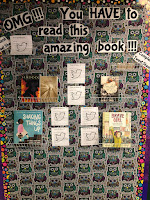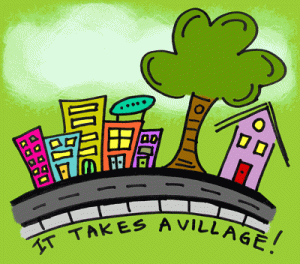Middle School Students CAN be Excited About Reading!
Hello Amazing Colleagues and Friends!
I am so honored and excited to be a part of this group this year and I can't wait to start sharing my classroom with you. It was a journey to get to where I am today and I am still learning every day,
but somehow I was pulled back to the middle repeatedly and I have decided that it is because I
belong here (even though it may have to take a few years to realize this). I'm the middle child in
my family teaching seventh grade in middle school. That means I'm a middle teaching the middle
of the middle. So here I am...Forever in the Middle (and loving it)!
but somehow I was pulled back to the middle repeatedly and I have decided that it is because I
belong here (even though it may have to take a few years to realize this). I'm the middle child in
my family teaching seventh grade in middle school. That means I'm a middle teaching the middle
of the middle. So here I am...Forever in the Middle (and loving it)!
Every year starts out with excitement and anticipation of new adventures and explorations and this year is different only in that I get to share my journey with all of you. This year, I will work to encourage enthusiasm for all things ELA with my middle schoolers, who are notoriously known for being a bit less than enthusiastic for life. I will share how I integrate collaboration, technology, and engagement strategies to make content meaningful to my students. My first goal: enthusiasm for reading.
As a middle school teacher, I have tried everything to get my students to read consistently every day so that they can improve lexile levels. Here’s the thing though: you can’t force a love for reading and lexile levels won't be improved drastically if a student is not reading because they do not enjoy it. I'm not sure what changes from elementary to middle school, but students seem to forget their love of reading that they so readily showed in elementary school. It has been a constant battle in all my years of teaching to re-ignite this spark.
In the past, I even went as far as singing a little song to the tune of Row, Row, Row Your Boat (Read, read, read your books for the whole ten minutes) then moved on to threatening (if you don’t read your books, you’ll stay late with me), but aside from a few eye rolls and reluctant compliance it made little difference. The most some students did was open the book and pretend to read. We all know what that looks like, don’t we? Realistically, at that point is the reading time really benefiting anyone?
What changed?
This year, after re-evaluating my own practices and reading some great professional development
books, I came back with a new approach and it’s the easiest thing I’ve ever done. It’s one of those
“Why didn’t I try this first” things: share my LOVE for books with kids so they see it’s cool to love books
in my classroom. They have forgotten their passion, but they aren’t too old to love reading and no one is ever too cool for it.
books, I came back with a new approach and it’s the easiest thing I’ve ever done. It’s one of those
“Why didn’t I try this first” things: share my LOVE for books with kids so they see it’s cool to love books
in my classroom. They have forgotten their passion, but they aren’t too old to love reading and no one is ever too cool for it.
 |
| "What I Want to Read" book lists from student notebooks (after our first big book talk day) |
From day one this year, I have talked about books, the students have handled books, and they have made lists of books they want to read--even the kids who came in declaring “I hate reading” have lists of books they want to read in their notebooks.
Last week I received my latest shipment of Scholastic books and we looked at all the books and SMELLED all the books! If you want to see some amused but happy faces, just walk through a class with a fresh book telling them to smell the fresh ink and paper. The looks on these young faces is priceless. I even tweeted a picture of my shipment and tagged authors of books I ordered. And guess what! Alan Gratz--the actual Alan Gratz of Refugee fame--replied to my tweet, Gordon Korman retweeted it, and Pam Munoz Ryan liked it! So today when showing the students all the new books for our library, I shared the tweets with them and they were just as excited as I was. In their eyes, I’ve made it on Twitter and I’m a celebrity already.

The chair I painted. Books are labeled with
titles of favorite books I have read or
books I have taught to my classes.
How did this change perspectives?
Now students are coming to me and actually asking to do book talks for the whole class! Honestly, the fancy chair may have helped that a little bit, but I don't even have to require book talks because they want to share what they are reading and feel safe in my classroom showing peers that they love reading. If you know middle school aged students, this is huge!
With all this craziness over books, the students can feel that I'm being genuine with them and that makes everything more meaningful to them.
The thought that "If my teacher puts this much emphasis on this, it MUST be important" is what the students will remember.

titles of favorite books I have read or
books I have taught to my classes.
What can you do in your own classroom?
1. Surround your students with great books. Check websites such as Great Reads for
recommendations. Also, notice which books are passed from one student to another and which
books they talk about with each other. Have students keep a running list of books they want to read.
recommendations. Also, notice which books are passed from one student to another and which
books they talk about with each other. Have students keep a running list of books they want to read.
2. Hold book talks frequently (less than 60 seconds). This can be teacher or student led and ends up sounding like a brief teaser for the book. There's a great Book Talk guideline at http://www.scholastic.com/bookfairs/books/booktalks and some great examples of Book Talks.
 |
| My reading recommendation and literature connections. |
4. Check in with students often about what they are reading and share in their enthusiasm for the book. This can be done during independent reading time with a few students each day. I keep a log and try to meet with 4-5 students each day in each class while the class is reading.
5. Make time for reading. It is one of my biggest priorities because without the ability to read and comprehend, all other subject areas suffer as well.
Even though students at this age have a reputation of being difficult, they really just want to feel like they are a part of something and they want to be important in someone's eyes. Letting them share their
interests through reading is a way to create a sense of belonging in your classroom. Your passion for learning and teaching will rub off your students and that is when you will see that spark ignite. Moments like that are what make every single day worth it.
Keep the magic alive,
Kandyce Valverde

:max_bytes(150000):strip_icc()/student-with-head-on-notebook-170026996-582f1fe23df78c6f6a01c935.jpg)





















